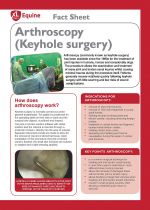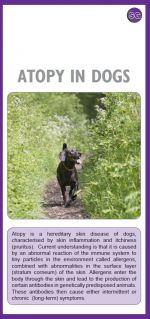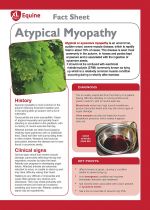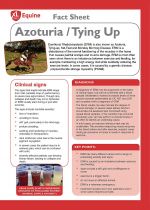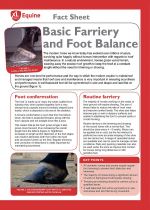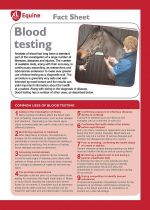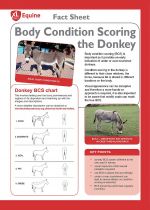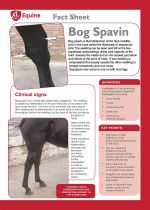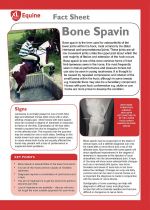Factsheets -
Below are Word and PDF files of our Factsheets. You will need Adobe Reader to view the PDF files - if you need to download Adobe Reader please click here.
Please note: some of these factsheets are several pages long and are large files, so please be patient when downloading!
Arthroscopy (Keyhole surgery)
Arthroscopy (commonly known as keyhole surgery)
has been available since the 1980s for the treatment of
joint injuries in humans, horses and occasionally dogs.
The procedure allows the examination and treatment
of many joint and tendon canal injuries whilst causing
minimal trauma during the procedure itself. Patients
generally recover relatively quickly following keyhole
surgery with little scarring and low risks of wound
complications.
Atopy in Dogs
Atopy is a hereditary skin disease of dogs, characterised by skin inflammation and itchiness (pruritus). Current understanding is that it is caused by an abnormal reaction of the immune system to tiny particles in the environment called allergens, combined with abnormalities in the surface layer (stratum corneum) of the skin. Allergens enter the body through the skin and lead to the production of certain antibodies in genetically predisposed animals. These antibodies then cause either intermittent or chronic (long-term) symptoms.
Atypical Myopathy
Atypical or sycamore myopathy is an uncommon, sudden onset, severe muscle disease, which is rapidly fatal in about 75% of cases. This disease is seen most commonly in the autumn, in horses and ponies kept at pasture and is associated with the ingestion of sycamore seeds.
It should not be confused with exertional rhabdomyolysis (ERM) commonly known as tying up which is a relatively common muscle condition occurring during or shortly after exercise.
Azoturia / Tying Up
Exertional Rhabdomyolysis (ERM) is also known as Azoturia,
Tying-up, Set-Fast and Monday Morning Disease. ERM is a disturbance of the normal functioning of the muscles in the horse that causes painful cramps and muscle damage. ERM is most often seen when there is an imbalance between exercise and feeding, for example maintaining a high energy diet while suddenly reducing the exercise levels. In some cases, it is caused by a genetic disease: polysaccharide storage myopathy (PSSM).
Basic Farriery and Foot Balance
The modern horse we know today has evolved over millions of years, surviving quite happily without human intervention with regards to hoof maintenance. In a natural environment, horses graze varied terrain, wearing away the excess hoof growth to keep the hoof at a constant length without the need for trimming or shoeing.
Horses are now bred for performance and the way in which the modern equine is maintained and managed means that hoof care and maintenance is very important in ensuring soundness and performance. A well balanced foot will be symmetrical in size and shape and land flat on the ground.
Blood testing
Analysis of blood has long been a standard part of the investigation of a large number of illnesses, diseases and injuries. The number of available tests, along with their accuracy, is continuously expanding, as researchers and laboratories endeavour to make ever greater use of blood testing as a diagnostic tool. The procedure is generally very safe and well-tolerated by most horses and the results can yield important information about the health of a patient. Along with aiding in the diagnosis of disease, blood testing has a number of other uses, as described below.
Body Condition Scoring the Donkey
Body condition scoring (BCS) is important as it provides an early indication of under or over nourished donkeys.
Condition scoring in the donkey is different to their close relatives, the horse, because fat is stored in different locations on the body.
Visual appearance can be deceptive and therefore a more hands-on approach is required, it is also important to be aware that woolly coats can mask the true BCS.
Bog Spavin
Bog spavin is fluid distension of the high mobility joint in the hock called the tibiotarsal or tarsocrural joint. The swelling can be seen and felt at the two superficial outpouchings of the joint capsule; at the front towards the inside and on the outside just below and infront of the point of hock. If one swelling is compressed this usually causes the other swelling to enlarge temporarily and vice versa.
Bog spavin can occur in one or both hind legs.
Bone Spavin
Bone spavin is the term used for osteoarthritis of the lower joints within the hock, most commonly the distal intertarsal and tarsometatarsal joints. These joints are all low movement joints unlike the upper joint about which the vast majority of flexion and extension of the hock occurs.
Bone spavin is one of the most common forms of hind limb lameness seen in the horse. It is most frequently seen in mature performance and pleasure horses but can also be seen in young racehorses. It is thought to be caused by repeated compression and rotation of the small bones within the hock; although in some breeds e.g. Icelandic there may also be a hereditary component. Horses with poor hock conformation e.g. sickle or cow hocks are more prone to develop the condition.
Bovine Coccidiosis
Coccidia are single celled protozoal organisms of the genus Eimeria. They have a complex life cycle involving both asexual and sexual reproduction.
